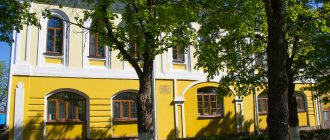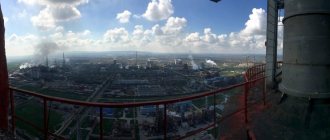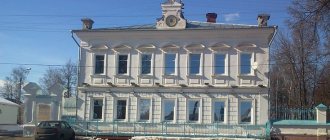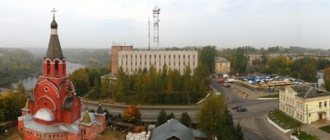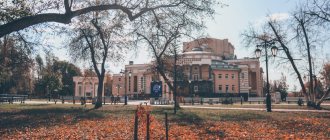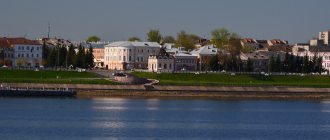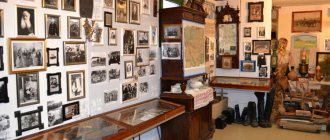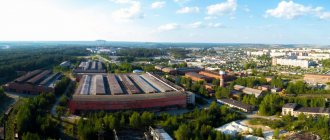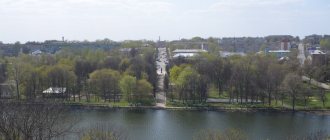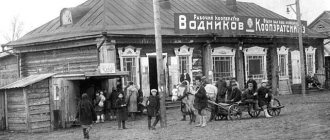| City Mikhailovsk Flag | Coat of arms |
| A country | Russia, Russia |
| Subject of the federation | Sverdlovsk regionSverdlovsk region |
| Municipal district | Nizhneserginsky |
| urban settlement | Mikhailovskoe |
| Coordinates | 56°26′00″ n. w. 59°07′00″ E. d. / 56.43333° n. w. 59.11667° east d. / 56.43333; 59.11667 (G) [www.openstreetmap.org/?mlat=56.43333&mlon=59.11667&zoom=12 (O)] (Z)Coordinates: 56°26′00″ N. w. 59°07′00″ E. d. / 56.43333° n. w. 59.11667° east d. / 56.43333; 59.11667 (G) [www.openstreetmap.org/?mlat=56.43333&mlon=59.11667&zoom=12 (O)] (I) |
| Based | 1805 |
| City with | 1961 |
| Center height | 250 |
| Population | ↘9191[1] people (2016) |
| Timezone | UTC+5 |
| Telephone code | +7 34398 |
| Vehicle code | 66, 96, 196 |
| OKATO code | [classif.spb.ru/classificators/view/okt.php?st=A&kr=1&kod=65228504 65 228 504] |
K: Settlements founded in 1805
This term has other meanings, see Mikhailovsk.
Mikhailovsk
- a city (since 1961) in Russia, district subordinate to the Nizhneserginsky district of the Sverdlovsk region.
Story
In 1805, at the mouth of the Kuba River, a tributary of the Sergi River, under the leadership of the Moscow merchant and industrialist Mikhail Gubin, construction of an ironworks began, which laid the foundation for the modern city. In August 1808, workers received the first pounds of sheet iron. The newly built plant and the workers' settlement located in the immediate vicinity were named after its founder and owner Mikhail Gubin - Mikhailovsky Plant. For the production of iron, mainly for roofing, cast iron was used from the Atigsky, Nizhneserginsky and Verkhneufaleysky factories. The finished products were floated down the Ufa River during the flood period. The main market for the metal was the Nizhny Novgorod Fair, and the main buyers of the products were the Serginskys and JSC Krovlya.
In 1860, three miles from the Mikhailovsky plant near the village of Ufimka, the Yates Ural stationery factory was built. Mikhailovsky was one of the large settlements in Krasnoufimsky district. There were up to 11 thousand people here, there was a volost administration, several schools (including a craft school), a hospital, a church, about 60 trade enterprises, and numerous trades (shoemaking, rolling, blacksmithing).
After the Civil War, the Mikhailovsky Plant was mothballed, so many residents of the village left for other Ural factories. In July 1925, the plant became operational again. There were already 800 workers employed here. From 1923 until its abolition due to the consolidation of the districts of the Ural region in 1932, it was the regional center of the Mikhailovsky district [2] of the Sverdlovsk district. In 1940, the plant produced 21 thousand tons of roofing iron. During the war years, the company developed products for the needs of the front. In particular, the production of rolled non-ferrous metals was organized: zinc, lead, aluminum, aluminum foil and tableware. The production specialization of the village began to change radically in the late 40s, when the Mikhailovsky plant switched to foil rolling production. In 1949, equipment brought from Kamensk-Uralsky for the production of foil used in radio engineering and the food industry was installed here. In 1959, foil rolling shop No. 2 was built at the plant, equipped with new German equipment. The paper mill was also reconstructed and began producing parchment. Enterprises were also built in the village to serve the needs of the population.
On January 9, 1961, the village of Mikhailovsky was transformed into the city of Mikhailovsk.
City `s history
As you know, most settlements in the Urals began to exist after the construction of a plant. The ancestor of the city of Mikhailovsk was an ironworks founded by Mikhail Gubin , after whom it was named.
The Mikhailovsky plant its work in August 1808. Until the 2000s, the same date was considered the founding day of the city, but over time it was decided to move this date back three years (1805), which corresponded to the time the construction of the plant began. The main products of the plant were bar and roofing iron and nails.
Photo by: Evgenia Zimina
In 1910, due to unprofitable production, the Mikhailovsky plant temporarily ceased its work, which forced the factory workers to move to another plant. Production was restored during the First World War , but not for long. The functioning of the plant was finally restored only in 1925.
During the Great Patriotic War, the Mikhailovsky Plant , like many other factories in the Urals , was repurposed to produce metal for military equipment, including aviation. In the post-war years, the plant never returned to its usual products - a foil rolling workshop was launched at the plant, and in the 50s the plant workers replaced iron with aluminum.
In 1961, the village was reclassified as the city of Mikhailovsk .
Photo by: Maria Shvydko
In 1980, the first rolling steel was installed in the city, making it possible to produce foil with a thickness of only 7 microns. During this period, the Mikhailovsky Plant occupied a leading position in the foil rolling industry. However, today most of the plant's buildings have turned into ruins.
Photo by: elina_ilkhamova
According to the population census for 2022, 8,921 people live in Mikhailovsk , while due to the lack of jobs for young people, the population is declining every year.
Economy
- LLC "Mikhailovsky RTI Plant"
It is part of the group of enterprises
of CJSC
[www.zavodrti.ru “Ural Plant of Elastomeric Seals” (UZEU)]. Specializes in the production of rubber products and raw rubber compounds. Actively participates in the social life of the city. Provides financial and material assistance to the orphanage in Mikhailovsk. - OJSC "Mikhalyum"
Specializes in the production of aluminum foil and steel-anti-friction aluminum alloys for automotive and tractor engineering. In the late 90s, it went through the bankruptcy stage, but was not declared bankrupt. External control of the plant was removed and a settlement agreement was signed. Currently part of OJSC Sual Holding. - LLC "Jasmine"
Specializes in the construction and repair of highways, production of asphalt concrete. The company was founded in 1991 on the basis of a mobile mechanized column. Over the years, the Jasmine team has built and put into operation about 50 km of public roads from Mikhailovsk to the Chelyabinsk region. A social support system has been preserved for the workers of the enterprise - a network of modern cottages and an apartment building have been built. “Jasmine” provides financial assistance to healthcare, educational, cultural and social assistance institutions in the city. - LLC "Mikhailovsky Dairy Plant"
The enterprise processes 500 tons of milk monthly. Product range: milk, sour cream, cottage cheese, curd mass, kefir and butter. - LLC "Mikhailovsky Bakery"
Every month it produces up to 800 tons of bread, bakery and confectionery products of 49 types.
Education and health
A network of preschool institutions is developed in Mikhailovsk. There are 1,500 children studying in three secondary schools in the city. Lyceum classes of the USPU, USGA, and Forestry University have been opened. A special general education correctional school educates and educates 90 children. On the basis of the House of Pioneers, the Rainbow Children's Creativity Center was created, in which 70 educational groups and 9 associations, 1050 school-age children attend various clubs.
In 1975, a secondary technical school was opened in the city, training groups of specialists: electricians, machine and tractor repair and maintenance technicians, and pastry chefs. Since 1978, a music school has been operating - the Children's Art School, where more than 100 children study piano and accordion. Many school teachers have been awarded the title “Excellence in Public Education.” Two were awarded the Sorov Prize. There are 2 libraries in the city - an adult and a children's. The central cultural institution of the city is the Palace of Culture of Metallurgists. There is an auditorium with a stage, the screening of feature films has resumed, all cultural events are held: concerts, theme evenings, amateur art shows, KVN, New Year and Christmas holidays, and interest clubs operate. Residents of the city who are interested in sports visit the Sports Complex, where there are 11 sections in athletics, volleyball, football, aerobics, sambo, bodybuilding, and powerlifting. Classes are taught by 6 masters of sports, two of whom are international masters of sports. The city’s athletes are participants and winners of various categories of competitions: from factory to international. The city hospital employs 21 specialists with higher and 80 specialists with secondary specialized medical education. There are departments of surgery, therapy, infectious diseases, a maternity ward, and a children's ward.
House, 1st floor
Nizhneserginsky district, st.
Ordzhonikidze, 227 House area: 31.5 m2 Plot area: 9.1 acres.
Shchipanova Galina
+7(952)731-86-73
850 000
rub.
More details
Forum
What is the standard of living in Mikhailovsk
May 31, 2022 I am interested in what is the standard of living and wealth of the population in Mikhailovsk. Are the salaries enough, how much do teachers and doctors receive? What about your medicine and education? Will it be possible to exist on just one...
Tsian Mikhailovsk
May 26, 2022 I have been using it for two years and posting advertisements for renting out houses. Everything seems to be fine, people are calling. ...
For those in France, as well as for those who watched French TV
June 17, 2022 1 In France, besides Fort Boyard, are there similar extreme programs? 2 Should there be something special in Fort Boyard in 2022? By date, 30 years on air, although the 30th anniversary was celebrated in 2019 3 In France there are programs ...
Is it normal for a guy who has a girlfriend to have a lot of girlfriends? Should you trust him?
July 8, 2022…
What do you do when you think they can't see you...?
July 28, 2022…
Book piracy on the Internet
June 26, 2022 Why can’t you download books from the Internet (engage in “piracy”)? How is this related to copyright infringement, but how exactly (at the legislative level)? ...
If you want to sell or buy inexpensively a house with a good repair in Mikhailovsk, look at the latest advertisements from owners and real estate agencies for January 2022: wooden, brick, frame, turnkey, timber, suburban and within the city. Sale for exchange with an additional payment, on credit without overpayment, on a mortgage, in installments from the developer, under the young family program and under maternity capital. There are houses in the private sector of Mikhailovsk with a plot of land, with above-ground buildings, plantings, a garden, a bathhouse, a garage, a vegetable garden and gas, sold cheaply and without intermediaries. Place ads with photos in the buy and sell sections.
Architecture and landmarks
| This article or section needs revision. Please improve the article in accordance with the rules for writing articles. |
On the central square of the city is the St. Michael's Church of the Ascension, built in 1892. She was one of the most beautiful in the region. In 1936 it was reconstructed as a club. Currently, extensive restoration work is underway here to give the church its original appearance.
Since 1972, a local history museum has been operating in Mikhailovsk. In 1999, the museum received new premises - the former house-estate of the merchant Varentsov, which is a monument to the history and culture of the city.
Wooden residential buildings predominate on the outskirts of the city. The city center is built up with multi-storey comfortable buildings.
How to get there?
Coordinates for GPS navigator
56.435805, 59.120491
Mikhailovsk on the map
Used sources
- Book by E. Vorobyova “On the Path to the 21st Century” / Factual database “Information about the Sverdlovsk Region”
- Mikhailovsk / Wikipedia
Interesting on the topic
MIKHAILOVESK & ARAKAEVO
The first time we were here in the furry year was for a performance in the winter night on New Year's holidays. All I remember is… Read more
Lovers of photography and travel are invited to a photo tour of the Urals!
Do you have a camera or phone and a great desire to become a photographer, but no knowledge? Then a photo tour is what you need! With… Read more
Women's tour: “Three paths to expanding horizons - choose yours!”
BRIGHT TOUR invites you to replenish the balance of vitality and fill yourself with positive energy. We devote the whole day, surrounded by the picturesque beauties of the Urals... Find out more
Oleniy Ruchi in autumn: weekend route
My first trip to Oleniy Ruchi Park took place in early autumn, when nature was just beginning to transform and change its color. We... Read more
Olenyi Ruchi Natural Park: attractions, how to get there, routes, photos
“Oleniy Ruchi” is a natural park located in the lower reaches of the Sergi River in the Sverdlovsk region. It was created in 1999 and ... Find out more
Weekend route: Arakaevo and Mikhailovsk
This time, two settlements were included in the weekend route list: the village of Arakaevo and the city of Mikhailovsk. The beginning of the route is ... Find out more
Tales of the Mitka Lakes
I’ve been to Oleniye Ruchi many times, but I always dreamed of walking the untrodden path – to the Mitkinsky mines. Finally the dream has come true! We... Read more
Mikhailovsky Museum of Local Lore
The first Mikhailovsky Museum of Local Lore was a public organization founded by a group of war and labor veterans on August 5, 1970 ... Read more
People associated with the city
- Troshin Vladimir Konstantinovich - singer, actor, People's Artist of the RSFSR (1984). In 1955, the actor went on stage performing songs by Soviet composers. His name is usually associated with the song “Moscow Nights,” which he first recorded for a documentary and then performed on the radio.
- Finogenov, Maxim Konstantinovich - Soviet worker and political figure. Hero of Socialist Labor.
- Fedotov, Vladimir Valentinovich - Soviet and Russian football player, later - football coach.
- Korovin, Kesar Mikhailovich - colonel of the Soviet Army, participant in the Great Patriotic War, Hero of the Soviet Union (1946).
- Ignatov, Igor Vladimirovich - Soviet and Russian football player, forward.
- Agapov, Mikhail Mikhailovich - Soviet and Russian football player and futsal player.
- Dodonov, Ivan Ivanovich - director of the Mikhailovsky plant from 1949 to 1973, just at this time the plant became a plant of all-Union significance and remained so until the 90s of the last century.
- Pevtsov, Alexey Vasilievich - writer, author of the book “Mikhailovsky Distributors”, 1985.
- Shimkevich, Lyudmila Valentinovna - journalist, editor-in-chief of the newspapers “Vestnik Mikhalyuma”, “Folga Ural” and the only newspaper in Mikhailovsk today “Municipal Bulletin”. It is thanks to L. V. Shimkevich that Mikhailovsk still has its own newspaper.
Information about the monuments of the city of Mikhailovsk.
1. Memorial complex “Fire of Eternal Glory”
The memorial complex “Flame of Eternal Glory” is located on Victory Square in the center of Mikhailovsk. The monument was built in 1974 in memory of those killed during the Civil and Great Patriotic War.
The authors of the monument are architect Albul D.V. and sculptor D.M. Kazachkov... The builders of the complex are workers of RSU-1 of the Shpakovsky district. Permission to open the monument is reflected in protocol No. 580 dated June 6, 1974. Department for Construction and Architecture under the Stavropol Regional Executive Committee. The complex occupies more than 4.5 thousand sq.m., and with an area of Victory of 25 t.sq.m... Material - reinforced concrete. The complex is represented by a stele - 30 meters high, base 2.5m x 1.6m, base 1.5m x 80 cm... On the base there is the inscription “Eternal memory to the soldiers who fell for the Motherland” 1941-1945... and an adjacent wall with a platform for laying flowers. In front of the wall there is a reservoir “Tears of Mothers” and a device (in the shape of a star) for fire. The entire complex is made of decorative concrete. At the foot of the obelisk there are three tombstones, where on the opening day, November 3, 1974, the remains of soldiers who died in the Great Patriotic War and transferred from different mass graves on the territory of the village were reburied. Shpakovsky. The memorial was opened in 1974. Spruce trees are planted on both sides of the memorial. Post No. 1 is open at the obelisk. Various events and rallies are held here, and a parade of military equipment has become traditional.
2. Monument to V.I. Lenin
Monument to V.I. Lenin in the village Shpakovsky was built in accordance with the order of the Council of Ministers of the RSFSR dated December 5, 1980. No. 1933-r and the Resolution of the Central Committee of the CPSU and the Council of Ministers of the USSR dated April 5, 1984. No. 285, and was opened on the newly built square on November 6, 1984. at 12 o'clock. The history of the monument is as follows: on January 21, 1924, V.I. Lenin, the founder of the Communist Party and the Soviet state, died. On January 27, 1924, at 2 o’clock in the afternoon, a funeral meeting of peasants took place in the village of Mikhailovka, at which the proposal was unanimously adopted: “...We have begun collecting money for the construction of a monument to V.I. Lenin.” After the meeting, the procession headed to the central school, where, amid a gun salute, the foundation for the monument to Ilyich was laid, but the monument was not built. Exactly 60 years later, the peasant’s dream came true - a monument to Ilyich was created. Authors of the monument: architect E.I. Kutyrev, sculptor Tirenkov. The monument was ordered in Moscow and cast in Minsk in Belarus. The project was accepted by the artistic expert council on monumental sculpture of the Ministry of Culture of the RSFSR. The monument includes a sculpture of V.I. Lenin, made in bronze with a height of 4.2 m, a pedestal in marble from the Autonomous Soviet Socialist Republic, 4.0 m, a platform 21 m long, 10 m wide, made in basalt (Armenian SSR ). This monument still adorns the central square of the city of Mikhailovsk. In Soviet times, solemn rallies were held every year at the foot of the monument on V.I. Lenin’s birthday, and schoolchildren laid fresh flowers. During the years of perestroika in some Russian cities, monuments to Lenin were removed from squares. In Mikhailovsk, a monument to the leader of the revolution has been preserved, they are taking care of it, and flowers are laid on significant dates.
3. Monument to A.S. Pushkin.
The history of the monument is as follows. Students from secondary school No. 1 approached the school director with a proposal to install a monument to Alexander Sergeevich Pushkin. In 1955, in January, a student of secondary school No. 1 Polis Yuri came to the director of the school Gurevich Izrail Borisovich with a proposal: - Israel Borisovich, our village is Mikhailovskoye and the native village of the poet Alexander Sergeevich Pushkin is also Mikhailovskoye. Let's erect a monument to A.S. in our village, at the entrance to the school. Pushkin on the 120th anniversary of the tragic death of the poet. This will be our gift to the school and village. We will do what needs to be done ourselves... This idea was also approved by the secretary of the district party committee A.M. Simonov. They found sculptors, art school students, and on August 31, 1956, a monument to A.S. Pushkin was installed in the courtyard of school No. 1, now school No. 24. Unfortunately, the names of the student craftsmen have not been preserved.
4. Monument to the hero of the Civil War F.G. Shpaku.
In memory of the hero of the Civil War. Mikhailovskoye was renamed Shpakovskoye on June 5, 1963. A street in Stavropol and Mikhailovsk is named after him. In 1965, in the village of Shpakovskoye (now Mikhailovsk), a bust was erected to him near the building of the district executive committee, designed by the architect F.I. Peretyatko. Material – reinforced concrete. In 1985, the bust was moved and installed at the entrance to the central park.
5. BAM - “Forgotten Corner” - this is what local residents call the territory of the center of Mikhailovsk along the Chla River.
Why exactly BAM can be understood only after knowing the history of this place. In the area of the bridge along Pochtovaya Street in 1975, a children's playground for go-karts, a small administrative building, the "Veterok" attraction, pedestrian bridges, and trees were built. On the other side of the bridge, a small sports plane and a helicopter were installed on pedestals, and a steam locomotive was brought from Mineralnye Vody. But a special event was the opening of a children's highway in 1976. It stretches from the bridge on Pochtovaya Street to the Prudy stop. The first secretary of the district committee of the CPSU, Vasily Petrovich Kuksov, saw her appointment not only as an entertainment program. Here children must learn the rules of the road: the road for this purpose had many markings and signs. There were stops here - each one different from the other in artistic design. Each of these stops was an island of a recreation area. Airport trolleys were used as a means of transport for this road. This converted tractor pulled two small trailers. This landscaped area looked so attractive that it was shown to foreign delegations who arrived in our region.
Notes
- ↑ 12
www.gks.ru/free_doc/doc_2016/bul_dr/mun_obr2016.rar Population of the Russian Federation by municipalities as of January 1, 2016 - [www.nzpr.ru/about/our-area/history History of the area], Official website of the Nyazepetrovsky district.
- ↑ 123456789
www.MojGorod.ru/sverdlov_obl/mihajlovske/index.html People's encyclopedia “My City”. Mikhailovsk (Sverdlovsk region) - [demoscope.ru/weekly/ssp/rus70_reg2.php All-Union Population Census of 1970 The size of the urban population of the RSFSR, its territorial units, urban settlements and urban areas by gender.] (Russian). Demoscope Weekly. Retrieved September 25, 2013. [www.webcitation.org/6GDOiMstp Archived from the original on April 28, 2013].
- [demoscope.ru/weekly/ssp/rus79_reg2.php All-Union Population Census of 1979 The size of the urban population of the RSFSR, its territorial units, urban settlements and urban areas by gender.] (Russian). Demoscope Weekly. Retrieved September 25, 2013. [www.webcitation.org/6GDOjhZ5L Archived from the original on April 28, 2013].
- [demoscope.ru/weekly/ssp/rus89_reg2.php All-Union Population Census of 1989. Urban population]. [www.webcitation.org/617x0o0Pa Archived from the original on August 22, 2011].
- [www.perepis2002.ru/ct/doc/1_TOM_01_04.xls All-Russian Population Census 2002. Volume. 1, table 4. Population of Russia, federal districts, constituent entities of the Russian Federation, districts, urban settlements, rural settlements - regional centers and rural settlements with a population of 3 thousand or more]. [www.webcitation.org/65AdCU0q3 Archived from the original on February 3, 2012].
- [www.gks.ru/bgd/regl/b08_14t/IssWWW.exe/Stg/ur/03-00.htm Administrative-territorial division of the Sverdlovsk region as of January 1, 2008]. Retrieved May 11, 2016. [www.webcitation.org/6hQQf5WLh Archived from the original on May 11, 2016].
- [www.gks.ru/bgd/regl/B09_109/IssWWW.exe/Stg/d01/tabl-21-09.xls Number of permanent population of the Russian Federation by cities, urban-type settlements and districts as of January 1, 2009]. Retrieved January 2, 2014. [www.webcitation.org/6MJmu0z1u Archived from the original on January 2, 2014].
- [sverdl.gks.ru/wps/wcm/connect/rosstat_ts/sverdl/resources/c081bf004cb2e2e8b07efb98f842dd0b/number and distribution of the population of the Sverdlovsk region.rar All-Russian population census 2010. Number and distribution of the population of the Sverdlovsk region]. Retrieved June 1, 2014. [www.webcitation.org/6Q0e0rzaI Archived from the original on June 1, 2014].
- [www.gks.ru/free_doc/doc_2012/bul_dr/mun_obr2012.rar Population of the Russian Federation by municipalities. Table 35. Estimated resident population as of January 1, 2012]. Retrieved May 31, 2014. [www.webcitation.org/6PyOWbdMc Archived from the original on May 31, 2014].
- [www.gks.ru/free_doc/doc_2013/bul_dr/mun_obr2013.rar Population of the Russian Federation by municipalities as of January 1, 2013. - M.: Federal State Statistics Service Rosstat, 2013. - 528 p. (Table 33. Population of urban districts, municipal districts, urban and rural settlements, urban settlements, rural settlements)]. Retrieved November 16, 2013. [www.webcitation.org/6LAdCWSxH Archived from the original on November 16, 2013].
- [www.gks.ru/free_doc/doc_2014/bul_dr/mun_obr2014.rar Table 33. Population of the Russian Federation by municipalities as of January 1, 2014]. Retrieved August 2, 2014. [www.webcitation.org/6RWqP50QK Archived from the original on August 2, 2014].
- [www.gks.ru/free_doc/doc_2015/bul_dr/mun_obr2015.rar Population of the Russian Federation by municipalities as of January 1, 2015]. Retrieved August 6, 2015. [www.webcitation.org/6aaNzOlFO Archived from the original on August 6, 2015].
An excerpt characterizing Mikhailovsk (Sverdlovsk region)
“I wanted to tell you one thing, princess,” said Rostov, “that if Prince Andrei Nikolaevich were not alive, then as a regimental commander, this would now be announced in the newspapers.” The princess looked at him, not understanding his words, but rejoicing at the expression of sympathetic suffering that was in his face. “And I know so many examples that a wound from a shrapnel (the newspapers say a grenade) can be either fatal immediately, or, on the contrary, very light,” said Nikolai. “We must hope for the best, and I’m sure...” Princess Marya interrupted him. “Oh, that would be so terrible...” she began and, without finishing from excitement, with a graceful movement (like everything she did in front of him), bowing her head and looking at him gratefully, she followed her aunt. In the evening of that day, Nikolai did not go anywhere to visit and stayed at home in order to settle some scores with the horse sellers. When he finished his business, it was already too late to go anywhere, but it was still too early to go to bed, and Nikolai walked up and down the room alone for a long time, pondering his life, which rarely happened to him. Princess Marya made a pleasant impression on him near Smolensk. The fact that he met her then in such special conditions, and the fact that it was her at one time that his mother pointed out to him as a rich match, made him pay special attention to her. In Voronezh, during his visit, the impression was not only pleasant, but strong. Nikolai was amazed at the special, moral beauty that he noticed in her this time. However, he was about to leave, and it did not occur to him to regret that by leaving Voronezh, he would be deprived of the opportunity to see the princess. But the current meeting with Princess Marya in the church (Nicholas felt it) sank deeper into his heart than he foresaw, and deeper than he desired for his peace of mind. This pale, thin, sad face, this radiant look, these quiet, graceful movements and most importantly - this deep and tender sadness, expressed in all her features, disturbed him and demanded his participation. Rostov could not stand to see in men the expression of a higher, spiritual life (that’s why he did not like Prince Andrei), he contemptuously called it philosophy, dreaminess; but in Princess Marya, precisely in this sadness, which showed the full depth of this spiritual world alien to Nicholas, he felt an irresistible attraction. “She must be a wonderful girl! That's exactly the angel! - he spoke to himself. “Why am I not free, why did I hurry up with Sonya?” And involuntarily he imagined a comparison between the two: poverty in one and wealth in the other of those spiritual gifts that Nicholas did not have and which therefore he valued so highly. He tried to imagine what would happen if he were free. How would he propose to her and she would become his wife? No, he couldn't imagine this. He felt terrified, and no clear images appeared to him. With Sonya, he had long ago drawn up a future picture for himself, and all of this was simple and clear, precisely because it was all made up, and he knew everything that was in Sonya; but it was impossible to imagine a future life with Princess Marya, because he did not understand her, but only loved her. Dreams about Sonya had something fun and toy-like about them. But thinking about Princess Marya was always difficult and a little scary. “How she prayed! - he remembered. “It was clear that her whole soul was in prayer. Yes, this is the prayer that moves mountains, and I am confident that its prayer will be fulfilled. Why don't I pray for what I need? - he remembered. - What I need? Freedom, ending with Sonya. “She told the truth,” he recalled the words of the governor’s wife, “except for misfortune, nothing will come from the fact that I marry her.” Confusion, woe maman... things... confusion, terrible confusion! Yes, I don't like her. Yes, I don’t love it as much as I should. My God! get me out of this terrible, hopeless situation! – he suddenly began to pray. “Yes, prayer will move a mountain, but you have to believe and not pray the way Natasha and I prayed as children for snow to become sugar, and we ran out into the yard to try to see if sugar was made from snow.” No, but I’m not praying for trifles now,” he said, putting the pipe in the corner and, folding his hands, standing in front of the image. And, touched by the memory of Princess Marya, he began to pray as he had not prayed for a long time. Tears were in his eyes and in his throat when Lavrushka entered the door with some papers. - Fool! Why do you bother when they don’t ask you! - Nikolai said, quickly changing his position. “From the governor,” Lavrushka said in a sleepy voice, “the courier has arrived, a letter for you.” - Well, okay, thank you, go! Nikolai took two letters. One was from the mother, the other from Sonya. He recognized their handwriting and printed out Sonya's first letter. Before he had time to read a few lines, his face turned pale and his eyes opened in fear and joy. - No, this cannot be! – he said out loud. Unable to sit still, he holds the letter in his hands, reading it. began to walk around the room. He ran through the letter, then read it once, twice, and, raising his shoulders and spreading his arms, he stopped in the middle of the room with his mouth open and eyes fixed. What he had just prayed for, with the confidence that God would grant his prayer, was fulfilled; but Nikolai was surprised by this as if it was something extraordinary, and as if he had never expected it, and as if the very fact that it happened so quickly proved that it did not happen from God, whom he asked, but from ordinary chance. That seemingly insoluble knot that tied Rostov’s freedom was resolved by this unexpected (as it seemed to Nikolai), unprovoked by Sonya’s letter. She wrote that the latest unfortunate circumstances, the loss of almost all of the Rostovs’ property in Moscow, and the countess’s more than once expressed desires for Nikolai to marry Princess Bolkonskaya, and his silence and coldness lately - all this together made her decide to renounce him promises and give him complete freedom. “It was too hard for me to think that I could be the cause of grief or discord in the family that had benefited me,” she wrote, “and my love has one goal: the happiness of those I love; and therefore I beg you, Nicolas, to consider yourself free and to know that no matter what, no one can love you more than your Sonya.” Both letters were from Trinity. Another letter was from the Countess. This letter described the last days in Moscow, the departure, the fire and the destruction of the entire fortune. In this letter, by the way, the countess wrote that Prince Andrey was among the wounded traveling with them. His situation was very dangerous, but now the doctor says there is more hope. Sonya and Natasha, like nurses, look after him. The next day, Nikolai went to Princess Marya with this letter. Neither Nikolai nor Princess Marya said a word about what the words could mean: “Natasha is caring for him”; but thanks to this letter, Nikolai suddenly became close to the princess into an almost family relationship. The next day, Rostov accompanied Princess Marya to Yaroslavl and a few days later he himself left for the regiment. Sonya's letter to Nicholas, which was the fulfillment of his prayer, was written from Trinity. This is what caused it. The thought of Nicholas marrying a rich bride occupied the old countess more and more. She knew that Sonya was the main obstacle to this. And Sonya’s life recently, especially after Nikolai’s letter describing his meeting in Bogucharovo with Princess Marya, became harder and harder in the countess’s house. The Countess did not miss a single opportunity to make an offensive or cruel hint to Sonya. But a few days before leaving Moscow, touched and excited by everything that was happening, the Countess, calling Sonya to her, instead of reproaches and demands, turned to her with tears and prayed that she, by sacrificing herself, would repay for everything. what was done for her was to break her ties with Nikolai. “I won’t be at peace until you give me this promise.” Sonya burst into tears hysterically, answered through her sobs that she would do everything, that she was ready for anything, but she did not make a direct promise and in her soul could not decide on what was demanded of her. She had to sacrifice herself for the happiness of the family that fed and raised her. Sacrificing herself for the happiness of others was Sonya's habit. Her position in the house was such that only on the path of sacrifice could she show her virtues, and she was accustomed and loved to sacrifice herself. But first, in all acts of self-sacrifice, she joyfully realized that by sacrificing herself, she thereby raised her worth in the eyes of herself and others and became more worthy of Nicolas, whom she loved most in life; but now her sacrifice had to consist in giving up what for her constituted the entire reward of the sacrifice, the entire meaning of life. And for the first time in her life, she felt bitterness towards those people who had benefited her in order to torture her more painfully; I felt envy of Natasha, who had never experienced anything like this, never needed sacrifices and forced others to sacrifice herself and yet was loved by everyone. And for the first time, Sonya felt how, out of her quiet, pure love for Nicolas, a passionate feeling suddenly began to grow, which stood above rules, virtue, and religion; and under the influence of this feeling, Sonya involuntarily, learned by her dependent life of secrecy, answered the countess in general, vague words, avoided conversations with her and decided to wait for a meeting with Nikolai so that in this meeting she would not free her, but, on the contrary, forever bind herself to him . The troubles and horror of the last days of the Rostovs’ stay in Moscow drowned out the dark thoughts that were weighing on her. She was glad to find salvation from them in practical activities. But when she learned about the presence of Prince Andrei in their house, despite all the sincere pity that she felt for him and Natasha, a joyful and superstitious feeling that God did not want her to be separated from Nicolas overtook her. She knew that Natasha loved one Prince Andrei and did not stop loving him. She knew that now, brought together in such terrible conditions, they would love each other again and that then Nicholas, due to the kinship that would be between them, would not be able to marry Princess Marya. Despite all the horror of everything that happened in the last days and during the first days of the journey, this feeling, this awareness of the intervention of providence in her personal affairs pleased Sonya. The Rostovs spent their first day on their trip at the Trinity Lavra. In the hotel of the Lavra, the Rostovs were allocated three large rooms, one of which was occupied by Prince Andrei. The wounded man was much better that day. Natasha sat with him. In the next room the Count and Countess sat, respectfully talking with the rector, who had visited their old acquaintances and investors. Sonya was sitting right there, and she was tormented by curiosity about what Prince Andrei and Natasha were talking about. She listened to the sounds of their voices from behind the door. The door of Prince Andrei's room opened. Natasha came out of there with an excited face and, not noticing the monk who stood up to meet her and grabbed the wide sleeve of his right hand, walked up to Sonya and took her hand.
